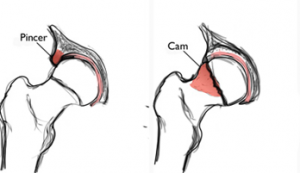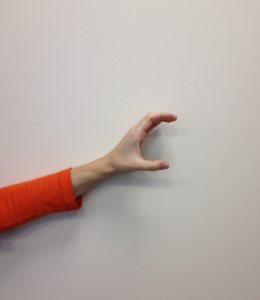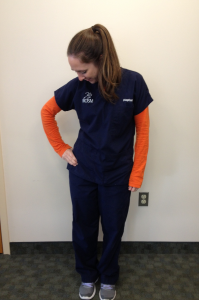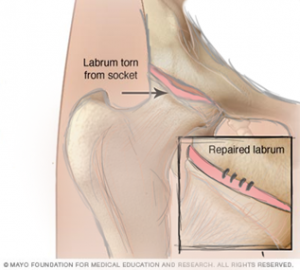
Over the past decade, our understanding of and ability to treat hip problems in athletes has grown exponentially. With the advent of advanced arthroscopic technology and techniques, we have been able to return people to their sports and lives in ways we couldn’t have imagined in years past. Additionally, we have developed a much clearer understanding of what the pain generators are in and around the hip.
What is the labrum?
Lately much attention has been focused on the labrum. In particular, a number of prominent athletes have recently suffered labrum tears and have been treated successfully with arthroscopic hip surgery, including Nicklas Backstrom of the Washington Capitals, Yankees star Alex Rodriguez, and Olympic sprinter Tyson Gay. At an anatomic level, the labrum is a fibrocartilaginous ring that encircles the superior 80% of the acetabulum (hip socket). Its job is to extend the depth of the hip socket and impart stability to the hip by deepening the hip socket and forming a fluid seal to manage the joint fluid within the hip.
When the labrum tears, it’s painful and can lead to further instability and breakdown of the rest of the hip. The good thing is that we now have excellent and proven techniques which—when done properly—can repair or reconstruct the labrum in an anatomically correct way which will restore the painless function of the labrum and the hip itself.
Why does the labrum tear?
About three-quarters of all patients with symptomatic hip labral tears will complain of an insidious onset of pain—that is, they don’t recall a specific injury that caused the hip pain; it just started one day. In approximately 90% of cases, there is an underlying abnormality of the bony structure of the hip that predisposes the hip to labral tears. This, in conjunction with the stress that athletes (or non-athletes) put on their hips, leads to labral tears. By far the most common underlying problem with the structure of the bone is what’s called Femoral Acetabular Impingement or FAI.
Understanding FAI
 While the hip is mechanically a complex joint that moves in multiple planes at the same time, and many factors can affect the ways in which an individual hip moves, the concept of impingement can be easily explained by simplifying the joint into one plane of motion and two types of impingement. The two types of impingement are called “cam” and “pincer.” If you imagine the hip as a simple ball and socket joint (it’s actually much more complicated), the cam type impingement comes from an abnormality of the ball; the pincer type comes from an abnormality of the socket. This quick video provides a nice explanation of the concept.
While the hip is mechanically a complex joint that moves in multiple planes at the same time, and many factors can affect the ways in which an individual hip moves, the concept of impingement can be easily explained by simplifying the joint into one plane of motion and two types of impingement. The two types of impingement are called “cam” and “pincer.” If you imagine the hip as a simple ball and socket joint (it’s actually much more complicated), the cam type impingement comes from an abnormality of the ball; the pincer type comes from an abnormality of the socket. This quick video provides a nice explanation of the concept.
What’s the problem with FAI?
There are many people walking around who have FAI and don’t know it. That’s ok. There is no reason to correct FAI if it is not causing symptoms. However, symptomatic FAI and labral tears, if unresponsive to non-surgical treatment, can cause persistent pain and disability and lead to progressive damage to the hip joint.
What type of symptoms do people with hip labral tears and FAI have?
The symptoms are variable. The most common pain is deep in the groin. This is often accompanied by pain elsewhere, often located more towards the surface (i.e., the side of the hip, the top of the hamstrings, the lower back, the SI joint, the lower abdominal wall, the adductor muscles, the piriformis/gluteal region, etc.). When we discuss this with patients, hip specialists will often use the term “C-Sign,” in which patients are asked to make a “C” with their hand and hold it around their hip to describe the location of their pain (see below).

Hand forming a “C.”

Using the “C” to indicate location of hip pain.
There are some athletes who will only have pain with cutting, twisting, and other explosive movements. More commonly, people complain of increasing pain with lighter and less demanding activities as time passes. Some common complaints include pain with sitting (particularly in cramped spaces like cars or planes), pain with running, pain with walking (especially on inclines), and pain with twisting activities such as getting in and out of a car. Sometimes the pain is manageable with decreasing activity level, while other times it can be debilitating in daily activities.
What is the treatment of FAI and labral tears?
The most appropriate initial treatment for all patients is to stop or modify the activity causing the hip pain. If this does not help, anti-inflammatory medications, physical therapy, chiropractic treatment, massage therapy, and selective injections can all be helpful in relieving the symptoms. If these methods fail to provide adequate relief or restore adequate function, then surgery is considered.
When FAI was initially described by Dr. Ganz’s group in Switzerland in the mid-1990’s, they described treating this with a large incision to dislocate the hip to reshape the ball and/or the socket to correct the mechanical problem. Fortunately, these days, in the hands of a skilled and experienced hip arthroscopist, the vast majority of these cases can be performed through two or three ½-inch incisions as an outpatient procedure.
Surgical treatment—my philosophy
Surgery should be the last resort. The human body has a tremendous capacity to heal itself or to make accommodations so that it can continue to function normally. When that is not the case, our goal as surgeons ought to be to restore the body and its anatomy to its most natural functional state. As most labral tears are caused by an abnormality of the bone and/or the soft tissue, it is important to not only address the labral tear, but also that which likely led it to tear.
Oftentimes, high-level athletes are able to continue to perform at a somewhat compromised level with a labral tear. Usually these tears do not need to be fixed urgently. It is safe, and often preferable, to wait to address a hip problem surgically (e.g., during the off-season) when people can dedicate themselves to taking a break and getting well.
Labral tears—how to treat
As discussed above, the labrum is an important structure in most hips that provides for stability and management of the flow of vital joint fluid with keeps the joint healthy, nourished, and lubricated. It is also important to decrease the forces and friction on the articular cartilage. It should be preserved, restored or reconstructed to the extent possible.
The labrum will sometimes tear in a peripheral location so that the main functional portion of it remains intact. This can be thought of as an irritant akin to a hangnail that can be simply removed without interrupting the functional integrity of the remainder of the labrum. In my experience, these types of tears represent a small minority of all labral tears.
Most tears are partial tears at the base of the labrum where it joins the bone and cartilage of the acetabulum and the stability of the entire labrum in that region is compromised. It is in this much more common scenario where the labrum should be repaired to restore normal anatomy, function, and durability of the hip for the long term. This has been borne out by multiple studies that have shown approximately two-thirds of people doing well with labral debridements (removing portions of the labrum), while over 90% of patients do well with repair of the labrum.

Most tears are partial tears at the base of the labrum where it joins the bone and cartilage of the acetabulum and the stability of the entire labrum in that region is compromised.
If the labrum has too much damage, the best thing to do is a reconstruction of the labrum. Here’s a video of an arthroscopic hip labral repair.
What about labral tears in people with arthritis?
When people develop arthritis in their hips, they also almost invariably have labral tears. Fundamentally, arthritis (technically osteoarthritis) is the breakdown of articular cartilage in the hip. We have a pretty good understanding now that labral tears and FAI can lead to arthritis. Unfortunately, once people have too much arthritis (damage or loss of articular cartilage), repairing or reconstructing their labrum and/or correcting their impingement is not usually worthwhile. We know this due to the high failure rate of arthroscopic hip surgery in patients with arthritis. So if you have a labral tear but also have too much arthritis, you’re better off not having any surgery other than a hip replacement when the time is right.
Take home message
If you have a labral tear that hurts and keeps you from doing the things you need to do—be it professional sports or just getting through the day—you should look into getting it repaired arthroscopically. While addressing the labrum either through repair or reconstruction, you should also have the reason why it tore addressed (usually FAI) at the same time. If you don’t have arthritis and choose a highly skilled surgeon whose practice is dedicated to arthroscopic hip surgery, your chances are very good of getting back to the things you need and love to do.
 Dr. Andrew B. Wolff is a board-certified and fellowship-trained orthopaedic surgeon and is widely recognized as one of today’s leading authorities in hip arthroscopy and preservation. He has many ongoing clinical research trials; regularly lectures at national and international hip meetings; and has helped develop and design techniques and instrumentation that have made arthroscopic treatment of hip problems easier, safer, and more reliable. Dr. Wolff is also a Consultant Reviewer of current research for the American Journal of Sports Medicine and the Journal of the American Academy of Orthopaedic Surgeons.
Dr. Andrew B. Wolff is a board-certified and fellowship-trained orthopaedic surgeon and is widely recognized as one of today’s leading authorities in hip arthroscopy and preservation. He has many ongoing clinical research trials; regularly lectures at national and international hip meetings; and has helped develop and design techniques and instrumentation that have made arthroscopic treatment of hip problems easier, safer, and more reliable. Dr. Wolff is also a Consultant Reviewer of current research for the American Journal of Sports Medicine and the Journal of the American Academy of Orthopaedic Surgeons.
Want to know more?
For more information about hip labral tears, email us or request an appointment.
Be sure to follow us on Facebook and Twitter as well!
